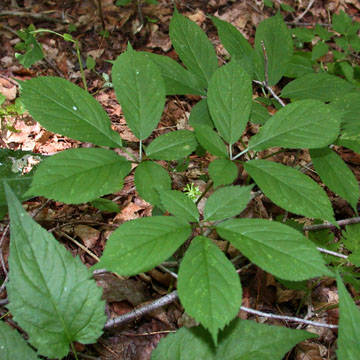

Panax quinquefolius - (image 1 of 4)
Taxonomy
Family: Araliaceae
Habitat
Rich woods in deep shade. Usually found on north-facing slopes.
Associates
Distribution
Quebec west to MN and SD, south GA to OK. Has become very rare due to over-collecting.
Morphology
Perennial herb from an elongate, fusiform (spindle-shaped) root. Stems solitary, to 60 cm. Leaves 1-4, palmately compound, typically with 5 leaflets; leaflets acuminate, serrate, the larger more than 8 cm long, on petiolules 1cm or longer. Flowers greenish-white, all or mostly perfect, in a terminal umbel on a solitary peduncle 1-12 cm long; styles typically 2. Fruit a small, bright red, berry-like drupe, with 2-3 pyrenes (stony structures derived from the endocarp, each containing a seed).
Notes
Flowers June to July.
Wetland indicator: Upland
The aromatic root is edible and is regarded as having medicinal value, resulting in the widespread over-collection of plants from the wild. Despite being one of the most popular herbal remedies, scientific studies demonstrating its efficacy seem to be lacking. A review of 16 double-blind, randomized, placebo-controlled trials concluded that efficacy of ginseng root extract for a variety of indications could not be established; indications included improvement of physical performance, psychomotor performance and cognitive function, immunomodulation (enhancement of the immune system), diabetes mellitus and herpes simplex type-II infections (Vogler et al, 1999).
Panax quinquefolius is currently protected in 10 out of the 34 states in which it occurs. Most of the ginseng in commerce today is the product of cultivation. The specific epithet is also spelled quinquefolium.
References
Gleason, Henry A. and A. Cronquist. 1991. Manual of Vascular Plants of Northeastern United States and Adjacent Canada. Second Ed.
The New York Botanical Garden. Bronx, NY
Peterson, L. A. 1977. A Field Guide to Edible Wild Plants: Eastern and central North America.
Houghton Mifflin Company. New York, NY
Swink, F. and G.
Wilhelm. 1994. Plants of the Chicago Region.
Indiana Academy of Science. The Morton Arboretum. Lisle, Illinois.
Vogler, B.K., M.H. Pittler and E. Ernst. 1999. The Efficacy of Ginseng. A systematic review of randomised clinical trials.
European Journal of Clinical Pharmacology 55(8)
|
Michael Hough © 2009 |